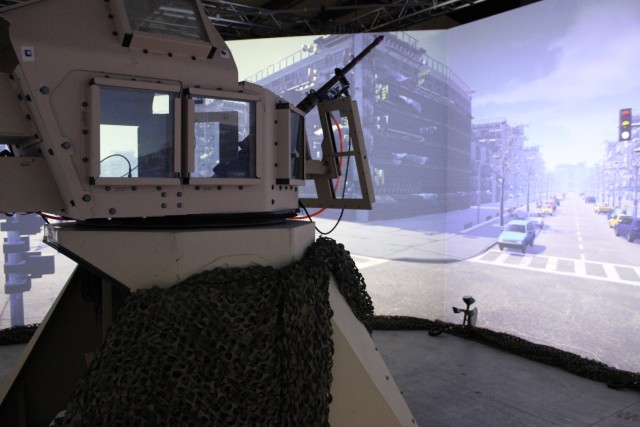
The Armaments Center at Picatinny leads the development of turret systems for armored and tactical vehicles. The designs are performed in-house along with the engineering analysis and prototype fabrication. Recent developments include the Objective Commander’s Weapon Station (OCWS) for the new Armored Multipurpose Vehicle (AMPV). The OCWS provides protection and firepower to the AMPV commander. VIEW ORIGINAL
PICATINNY ARSENAL, N.J. - U.S. Army Soldiers are using gaming environments to work side-by-side with engineers at the U.S. Army Combat Capabilities Development Command Armaments Center at Picatinny Arsenal, with the goal of improving lethality, survivability and situational awareness for gunners.
The Armaments Center at Picatinny leads the development of turret systems for armored and tactical vehicles. The designs are performed in-house along with the engineering analysis and prototype fabrication. Recent developments include the Objective Commander’s Weapon Station (OCWS) for the new Armored Multipurpose Vehicle (AMPV). The OCWS provides protection and firepower to the AMPV commander.
“When designing new gunner protection kits (GPKs), such as the OCWS, it’s always helpful to build prototypes early-on for evaluation with the users,” said Thomas Kiel, who leads the design activity for turret systems at Picatinny. “But physical prototypes take time to fabricate and can be costly,” he added.
Engineers at Picatinny have adopted a more modern approach to visualizing their designs as they’re being created. Virtual and augmented reality tools enable the team to have a more accurate perspective of the design before physical prototypes are built, saving time and money.
Armaments Center engineers at the Tactical Behavior Research Laboratory (TBRL) in collaboration with the Gaming, Interactive Technologies, and Multimedia (GITM) branch were tasked with developing a smart, full-scale, virtual, and augmented reality simulation environment for the next-generation of GPKs that will significantly enhance the operational evaluation of turret designs.
The integration of virtual reality (VR) testbeds in military evaluation provides a cost-effective and controlled means of assessing Soldier-in-the-loop system performance, user behavior, and decision-making under simulated combat conditions.
The testbeds provide a mixed reality experience that allows the user to see their real-world hands controlling a physical mock weapon to engage virtual targets in a simulation environment.
With the aid of Soldiers, engineers at the Armaments Center’s TBRL then conducted a study collecting and analyzing data on Soldier immersion, physiological stress responses, and performance outcomes across two VR testbeds, a VR headset and a 360-degree octagon projection system (Virtual Employment Test Bed (VETB))—simulating engagements in a gunner protection kit (GPK). Through iterative design and several weeks of Soldier engagements, 26 Soldiers went through early iterations of the testbeds and helped engineers at TBRL ensure that the environments and scenarios were realistic, Soldiers provided feedback on realism and validity as well as improvements to future interactions of the testbeds based on in-house developed survey tools.
Using the final iteration, ten Soldiers participated in a within-subjects design, completing identical scenarios in both environments while physiological stress markers, user feedback, and performance metrics were recorded.
When using the headset, participants were asked to stand as they would in a real GPK and engage enemy targets in a weapons-free environment. Throughout the testing, participants were monitored by a researcher.
The second testbed required participants to be located inside a mock GPK, operating as if it was the real system. The environment consisted of eight 4K projectors, displaying the environment within an octagon displaying a 360-degree view around GPK. The GPK was armed with a de-milled M2 machine gun modified for use in virtual environments. The de-milled M2 provided some recoil and allowed for reloading and targeting withing the virtual environment. Additionally, rubber pellets were fired from virtual enemy positions aimed at the base of the kit to simulate incoming enemy fire.
“Computer models are only as big as the monitor on your desk that displays these,” said Kiel. “VR allows us to appreciate the true size of a weapon system while being fully immersed in how it actually functions.” The turret test bed at the TBRL has been used to evaluate new designs as well as proposed enhancements to the systems, such as increased visibility for gunners.
Results indicate that the Octagon system elicited higher stress levels and improved situational awareness compared to the VR headset, while the headset facilitated greater engagement and lethality, with participants firing more rounds and defeating more targets.
These findings suggest that an optimal testbed would integrate elements from both VR approaches to enhance realism, immersion, and stress induction to ensure the most realistic response from Soldiers during prototype testing.
The OCWS turret was trimmed down significantly from its initial configuration following virtual and physical prototype evaluations. For example, the armored side walls were optimized to reduce weight and material usage, while additional transparent armor windows were included at the request of soldiers to enhance situational awareness.
The OCWS currently is in full-rate production for all five variants of the AMPV and is being fielded to units in Fort Stewart, GA.

VIEW ORIGINAL


Social Sharing